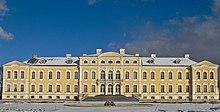Rundāle Castle
Rundāle Palace (also: Schloss Ruhenthal , Schloss Ruhental and Schloss Ruhendahl , Latvian Rundāles pils ) is a state-owned baroque palace in the Latvian region of Semgallia , 10 kilometers west of Bauska , which has been in state ownership since 1920 . It is often referred to as the Versailles of the Baltic States .
architecture
Rundāle Palace is one of the most important Baroque and Rococo monuments in Latvia. It was designed on the model of the French Palace of Versailles. The three-winged, two-story castle houses 138 rooms and halls on almost 7,000 m². The palace park is also laid out in the French style .
history
The construction of the castle was initiated by the Russian Tsarina Anna Ivanovna and was intended to serve as the summer residence of the Courland Duke Ernst Johann Biron . The Russian-Italian architect and builder at the Tsar's court, Bartolomeo Francesco Rastrelli , who had already drawn up the plans for the Winter Palace of the Hermitage in St. Petersburg, was commissioned with the design. The foundation stone was laid in 1735, the construction work initially lasted until 1740. The palace park was also laid out according to Rastrelli's specifications in the French style and planted with 328,185 linden trees. Biron only used the castle for three years, as he was exiled to Siberia after the death of Tsarina Anna. Only when Tsarina Catherine II came to power , Biron was able to return to Courland. Between 1763 and 1768 construction work was carried out on the castle again and, above all, the interior furnishings were completed. The interior design was in the hands of the St. Petersburg-based Italian painters Francesco Martini and Carlo Zucchi and the Berlin sculptor Johann Michael Graff. After Biron's death, his son, Duke Peter von Biron , used the castle until 1795. After the Duchy of Courland and Semgallia had been annexed by the Russian Empire in 1795 and the ducal house of Biron von Curland had been financially compensated, the Tsarina gave the castle to her favorite, Count Platon A. Subov . Before that, Peter von Biron had already removed most of the inventory. The castle later came into the possession of the Shuvalov family. As part of the Latvian agrarian reform, the castle, which had been damaged in World War I, was expropriated in 1920 and became the property of the Latvian state. Apartments and a primary school were established in the buildings. In 1933 it was given to the Latvian Historical Museum and some renovations began. The exterior of Rundāle survived the Second World War undamaged, but it was used as a granary in the post-war years , and a large part of the valuable interior was destroyed. The Rundāle Palace Museum was founded in 1972 and extensive restoration work began.
Current usage
Rundāle Palace Museum is a research center for the earlier art history of Latvia. It houses the exhibition “Art Treasures in Rundāle Palace”. This contains exhibits of the art of Europe and the East from four centuries. Furniture, porcelain, silver, paintings and legacies of the dukes of Courland are on display . The special exhibition "House Biron Abroad" deals specifically with the family of the first lord of the castle. After the extensive renovations, during which the original and valuable silk wallpapers were renewed, the Golden and White Halls are open to the public in their original splendor. The director of the museum is Imants Lancmanis .
literature
- Rundale Palace - Rundale Palace Museum , text Imants Lancmanis , photos Ints Lusis, translation Sarmite Pijola, Rundale 2003, ISBN 9984-9098-5-9 .
- Baltic countries. Travel guide , Michael Müller Verlag, Erlangen 2008, ISBN 978-3-89953-380-4 , p. 441.
Web links
- Official website of the Castle Museum (German, Latvian, English)
- Georg Dehio Culture Prize 2007
- Rundale Palace as a 3D model in SketchUp's 3D warehouse
Coordinates: 56 ° 24 ′ 46.4 " N , 24 ° 1 ′ 31.8" E



